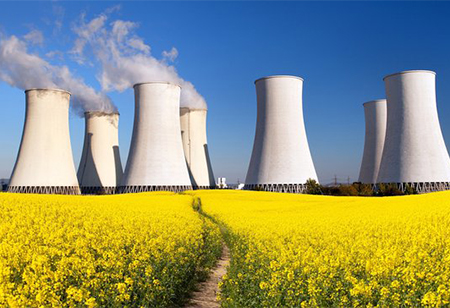
Advanced Nuclear Technologies: The Forerunners of the Low-Carbon Economy


A key aspect of the shift to a low-carbon economy is the use of advanced nuclear technologies. The government's commitment to constructing large, small, and cutting-edge nuclear plants was confirmed by the Ten Point Plan for a Green Industrial Revolution and the 2020 Energy White Paper. Nuclear power has recently been emphasized as a crucial component of the UK's energy mix as we move towards net zero in the Net Zero Strategy. In the Net Zero Strategy, it is indicated that a new Future Nuclear Enabling Fund would receive up to £120 million in funding to give targeted support for removing entry-level obstacles. The government is planning to use this fund as one of its tools when making investment choices for new nuclear projects throughout the ensuing Parliament.
What are Advanced Nuclear Technologies?
Numerous nuclear reactor technologies are now being developed under advanced nuclear technologies. The technologies have several features in common:
- Smaller than conventional nuclear power station reactors
- Designed so that much of the plant can be fabricated in a factory environment and transported to the site, reducing construction risk and making them less capital-intensive
The SMRs could be a key low-carbon energy source for a safe, economical, decarbonized energy system, working in tandem with major nuclear power facilities. SMRs are more compact, and their flexible deployment may be enabled via off-site, modular fabrication.
The government said it would implement a First-of-a-Kind SMR by the beginning of the 2030s in both the Ten Point Plan and the Energy White Paper. The government will continue to make progress on important market and policy enablers, including completing SMR finance, siting, and regulatory access.
Advanced Modern Reactors
AMRs are the name given to Generation IV reactors by the government. These reactors utilize the same modular-build concepts as SMRs and generate low-carbon electricity using cutting-edge fuels, coolants, and technologies.
Numerous novel reactor technologies are currently being developed in several advanced nuclear markets across numerous countries. A variety of applications other than low-carbon electricity generation are possible for many designs, including:
- production of hydrogen
- direct heat for industrial or domestic use
- nuclear waste management solutions
Nuclear Reactors to Watch in the Upcoming Years
BWXT Advanced Nuclear Reactor
For use in the early 2030s, BWX Technologies is creating a transportable microreactor that can generate 50 megawatts of thermal energy and flourish in off-grid applications and remote locations. The DOE's TRISO fuel is used in the high-temperature gas reactor in a new form with a fuel kernel made of uranium nitride for improved performance. In order to reduce the cost of microreactors in half and to develop capabilities that could help other advanced reactor designs, researchers are concentrating on optimizing new manufacturing processes.
Advanced reactors can boost our economy, produce thousands of new employment here at home, and reduce emissions simultaneously. Reserchers assist in reestablishing the country's position as the world leader in the technology they initially created by proactively pursuing a wide portfolio of US reactors.
eVinci Microreactor
A transportable micro reactor that can be installed on-site in less than 30 days is another goal of Westinghouse Electric Company. The 15-megawatt thermal reactor runs flexibly off-grid or in remote areas using TRISO fuel and a specialized heat pipe design. To test and produce parts for its heat pipe and moderator in order to create a tiny demonstration unit, the business will collaborate with Texas A&M University, INL, and Los Alamos National Laboratory. This two-year project is a part of Westinghouse's larger initiative to show a prototype reactor by 2024, with full commercial deployment anticipated for the mid-to-late 2020s.
Hermes Low-Power Demonstration Reactor
Hermes is a crucial step in the company's quick iterative development process to demonstrate that its high-temperature fluoride salt-cooled reactor can ultimately provide affordable nuclear heat. With a molten fluoride salt coolant and TRISO fuel pebble bed architecture, the reactor will have a 35 MWth thermal power level. Hermes, which could be operational by 2026, will be the forerunner to Kairos Power's upcoming 140 MWe commercial reactors.
Holtec SMR-160 Reactor
With the goal of demonstrating its innovative light-water small modular reactor, Holtec is working with Kiewit Power Constructors, Framatome, Mitsubishi Electric Power Products, Western Services Corporation, and INL to finish the early-stage research and power plant development work. The 160-megawatt electric design can be modified to utilize air-cooled condensers on its secondary side, enabling it to be installed in the world's driest locations. Holtec can manufacture the majority of the components here in the United States thanks to its superior manufacturing capabilities. Following the decommissioning of the nuclear power facility, they intend to exhibit the reactor at the Oyster Creek location in New Jersey.
Molten Chloride Reactor Experiment
The MCFR may be expanded for grid-based commercial use and is flexible enough to run on various fuels, including leftover nuclear fuel from other reactors. To build the first fast-spectrum salt reactor in the world, Southern Company will collaborate with TerraPower, CORE-POWER, Orano, and EPRI, as well as other commercial businesses, research facilities, and academic institutions. For thermal storage, process heat, or electricity generation, MCFR technology transmits heat with astounding efficiency. Within the next five years, a demonstration reactor that will be based on the results of the molten chloride reactor experiment will be able to operate.